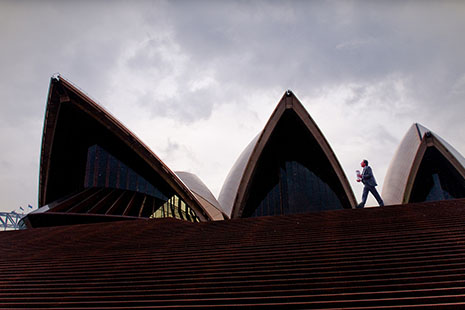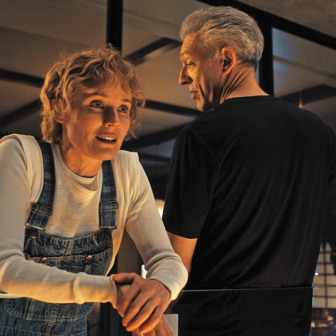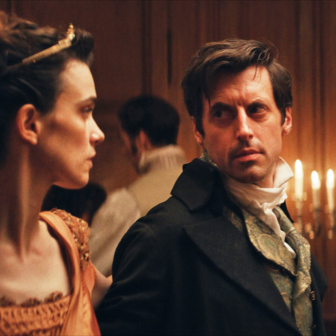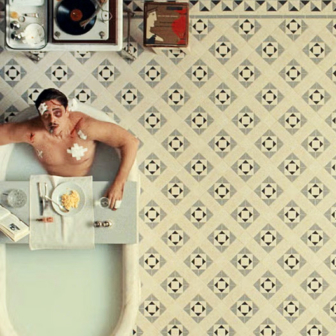SOMETIMES the most unlikely fusion of modes can actually work. In the extraordinary case of The Eye of the Storm, it must have taken high courage from the director Fred Schepisi, the actor-writer Judy Morris, their producers – and a whole array of Australian funding bodies – to go anywhere near that novel, which in itself is nothing short of magnificent. This film was a giant gamble, and they won. It had to be an actors’ film, and has been judged and summarised as such; but to the great credits of director, writer, cinematographer Ian Baker and the entire team, it is very much more.
It’s all stops out, high theatre as cinema, rising to the operatic with the actual storm on the island. That event is cinematic splendour; but the film works to open up the greater storm, the one made by the energies let loose within a family and a household at the time of a central death, the kind of death that is both desired and dreaded by next of kin and inheritors. Such an event leaves the survivors beached, with nothing much to do and, in these cases – those of Elizabeth Hunter’s drifting middle-aged children – little psychological equipment to make adequate sense of either her life or their own. It’s in the extended family, that of the nurses and carers, that the violence is exercised; and with the cast, Morris’s finely spun script ensures that each of them becomes more than a function. Alexandra Schepisi is a marvellous schemer, Flora the nurse, who fails to trap the appalling Sir Basil (Geoffrey Rush); Helen Morse negotiates the sadness and horror of Lotte, the servant and dancer, who had only her role for Elizabeth to live for. John Gaden as the family solicitor Wyburd – and this is far from a simple retainer’s role – is as good as he always is, and that’s saying a lot.
The principals, Charlotte Rampling as Elizabeth, Judy Davis as the acid, defeated Dorothy de Lascabanes, and Rush do more than inhabit their roles; they work together, making sense not simply of persons but more tellingly of relationships. Rampling was a great choice, glinting from the pillows under a variety of wigs, encompassing both the malign matriarch and also the needy one, whose relations with her children are infinitely complicated. She and Davis make real the mother–daughter duo, stumbling to come to terms around Elizabeth’s undignified end: last-minute humiliation for an intransigent patrician (this actually happened to Patrick White’s mother Ruth). Brother and sister together can tell more of the truth than they ever could apart, though Sir Basil the London actor, with the failed Lear in his record, will go on kidding himself. Geoffrey Rush has never been funnier.
I don’t know how often the Melbourne mansion Ripponlea has done filmic service for the wealthy, traditional Anglo-Australian households of fiction, but here it is again, at least as an exterior setting. Whether the interiors belong to it I don’t know, but with dark polished rooms, draperies and fine furniture, they fill out the trappings of that squattocracy’s world that nurtured Patrick White in his well-being, his attachments and his hatreds. The drama is centred in such a house in White’s Centennial Park, Sydney; but Sydney’s here in only glimpses – black swans on the lake in that park, a harbour ferry and, more significantly, the arches of the Opera House when Rush’s Sir Basil climbs the grand stairway and parades briefly on the outside of those spaces he’d have loved to enter as a performer. (This could have been meant as a signature moment; did Schepisi and Morris know that White appeared, publicly and bravely, as a supporter of Jørn Utzon in the crisis days of 1966?)
There are regaling contrasts and visual mood changes, from the oppressive rooms to the country house, the forested island, the sandy roads among the paperbarks; while the beach and waters at the end offer a certain kind of redemption. There the story forgives Elizabeth, as the servants do. Some critics have been tougher, commenting on the way the film transmits White’s misanthropy; once entered into, however, that dim view of motive and character is also a complex one, yielding up a lot more than we asked. Schepisi and Morris do it justice. There’s a vista here. Both film-makers and readers – the latter including literary critics – could yet do more to meet the challenges posed by Patrick White. After many failed projects on Voss, that terrifying visionary tale may remain eternally unfilmable, and so be it; not so the rest.
CHANNELLED through Geoff Gardner’s invaluable e-mail circuit Film Alerts, there has been one proper challenge to dominant opinion about another Australian film currently playing. Geoff supplies his readers with box-office figures for Australian productions, as well as rounding up critical views, and reminding all of us what we ought to be recording from SBS 2 at 3 am. After his note last month on the record-breaking box-office success of the amiable, kelpie-centred Red Dog, Geoff ran this response from Tom Ryan, regular critic for the Sunday Age (excerpted):
I fear that your unrelenting focus on box-office figures for Australian films has led you to overlook one very important fact about Red Dog. That is: at a time when Australia’s dark side has been so clearly exposed, its production and release is [sic] pernicious.It insists… that we’re a nice multi-cultural nation, and that the spirit of Australia imbedded in a dog covered in Pilbara red is all that’s required to bring us all together. We’re all lapping this up, toddling off to the box-office to pay our money, to be patted on the back and to be reassured that we’re all good (white) folks, while (racist) crimes against humanity are being committed in our name.
By all means celebrate box-office figures if you must. But please don’t present the films as if they’re simply a means to an end. What they have to say and their quality or lack of it matter a lot more than the money they make.
Red Dog is among other things a great rendering of the red gravel of the Pilbara, where most of us don’t live and not so many actually go (superb cinematography by Geoffrey Hall, with the script from Louis de Bernières’s novel by Bernières and Daniel Taplitz). It is otherwise a kids’/young adult film, meant to make the audiences feel good and just a little weepy; Koko the kelpie is a wholly engaging central character in the long, long line of feel-good animal-centred movies since Lassie Come Home (1943, with the late Liz Taylor, aged twelve, starring with the collie). In fact Red Dog’s supporting cast is not all white, nor all Anglo; and on Tom Ryan’s side, I’d have been glad myself to see a few more Aboriginal faces. Racism and xenophobia are taken up, if only mildly, in the opening sequences; and it must be said that Kriv Stenders emerges again as one very good director, who now needs a more complicated subject.
If Tom Ryan is thinking especially of the villainous policy on asylum-seekers – still current after all these years – and of the racist and discriminatory Northern Territory Intervention, I am more than all with him. (They’re some of the main reasons I vote Green rather than Labor.) But this film is only inside our targets if we insist on taking it as nationally representative. It is not. It addresses a particular market; it is talking to ten-, twelve- and maybe fourteen-year-olds. It takes them out of the suburbs. It gives a benign version of community (so, in their days, did John Ford and Jean Renoir). And no, we shouldn’t be lying to them; but how many stories will you ask them to take on at once?
The campaign to fight is one that would, among other things, get Ivan Sen’s Toomelah – seen and briefly discussed after the film festival screenings – on to the wider circuits. From then find the writers, and directors of Kriv Stenders’s and Warwick Thornton’s calibre, who’ll take on the detention centres and the policy-plagued outback communities in feature-film genres. There are producers and distributors to be supported as well, with attention to their struggle for local and wider markets.
Not least we – the writers on the sidelines – can be extending our responses to those other film-makers, the documentarists, who struggle hard to tell the truth on those battlefronts. Meanwhile, it is a truth not sufficiently acknowledged that we can’t fight effectively on all fronts at once. •





